

SUMMARY
(Health) care analytics refers to the use of collected data to provide organisations or patients with actionable insights. These insights are developed through analytical disciplines to drive fact-based decision making. In turn, these decisions improve planning, management, measurement and learning.
Our CareAnalytic in this context is defined as a contextually-aware procedure or algorithm which can detect and react to patterns in current or historic data available to the systems. CareAnalytics are one element of the person-centric analytics platform developed for the ProACT ICT-AT solution. These set of CareAnalytics have different objectives and outcomes, but they have one thing in common: all of them are defined as person-centred analytics, that is, they are focused on the analysis of the behaviour of the person at different moments to automatically produce outcomes in order to achieve different goals (correct bad habits, classify, find patterns, etc.). These automatic outcomes have been beed produced by using machine learning techniques.
We have developed a set of CareAnalytics:
Motivation
A person-centred analytics to provide a holistic view of the status of a person based on the BPPS (biological, physiological, psychological and social conditions) model. The information extracted from the CareAnalytics is oriented to the person himself/herself, to the informal carer, to the formal carer or to the healthcare professional.
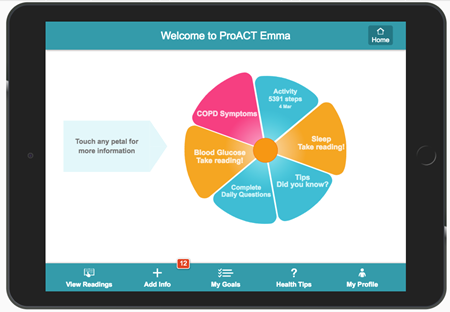
The output of the CareAnalytics translates not only into an immediate result of an analysis displayed in a healthcare application, it can also translate into an intermediate process that, by using machine learning techniques, allows improving the performance of a general system. Such intermediate processes allow us, for example, to add intelligence to the system or to build analyses to obtain key metrics for a better functioning of the ecosystem. The results of these types of processes are not shown directly to any of the 4 key care support actors, but they have an ultimate impact on their user experiences and consequently on the quality of life (QoL) of the patient.

Data
The data used to create the analytical methods come from a range of different sources: sensors which provide information about status or activity (e.g. weight, blood glucose, etc.) and surveys/questionnaires which contribute additional information that is not observed with the included sensor devices. The status inputs are not only key parameters for self-management, but can also provide interesting insights for implementing predictive algorithms when a sufficiently large dataset is available. These data are mostly used in those CareAnaytics whose main objective is to evaluate measurements in order to detect risks and classify persons with multimorbidity (PwM) automatically.
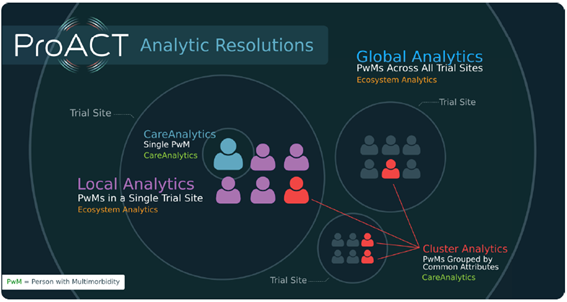
Data Cleaner
Some outliers and anomalies may be contained in data (especially concerning the vitals). To deal with these problems and other possible inconsistencies in the numerical values, we have developed a DataCleaner analytics feature: it takes a set of numerical measurements as input and compares these values with their historical behaviour to finally return a label as output: normal / outlier.
Type of data processed by the Data Cleaner include: Blood glucose, Blood pressure, Calories, Distance, Pulse, Steps, Steps Elevation, Time_inside_outside, Time_walking, Weight, SPO2 .
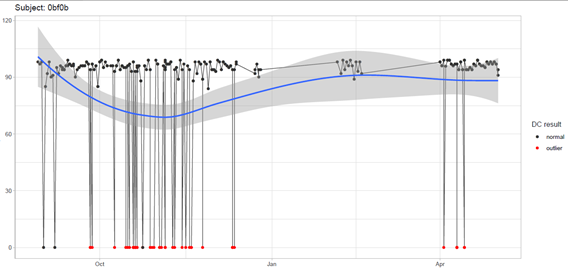
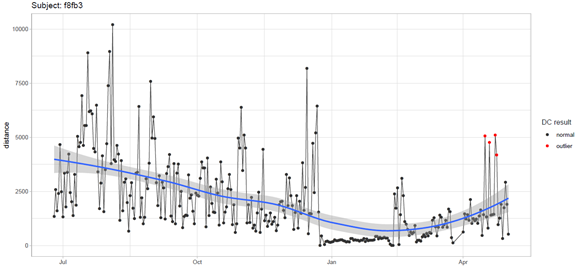
Data Cleaner classification example for SpO2 (Fig. A); DC classification example for steps and distance (Fig. B)
User Engagement Analyser
User Engagement (UE) is a notion used in different fields. It has been treated as a process itself and also as a state within a process, as an experience, a degree, a connection and as an indicator of the relation between a person and a product. UE is related to User Experience (UX): both find it important to appeal to a person’s emotions and feelings and to create some form of fidelity. According to O’Brien et al. (2008), the UE is the quality of users' experiences with technology and is comprised of attention, affect, aesthetics, novelty, interest, control, feedback, challenge, and motivation. According to the compositional thread, engagement is a process whereby users pass through stages of becoming engaged, staying engaged, disengaging, and re-engaging. This process is situated in a specific spatio-temporal context, i.e. time and place.
We have designed the User Engagement (UE) Analyser to explore detailed user engagement patterns within the front end CareApp. From this analysis we have been able to investigate how users interact with their health data. For example, if they view readings in a graph or table format or in what modality they have viewed health tips. This granular analysis is key to explore user preferences and engagement with individual features within the CareApp. The UE Analyser studies, on a daily basis, the navigation done through the CareApp: buttons pressed, connection times, sections visited, etc. The analytic takes this raw information, process it and produces a summary that can be easily interpretable.
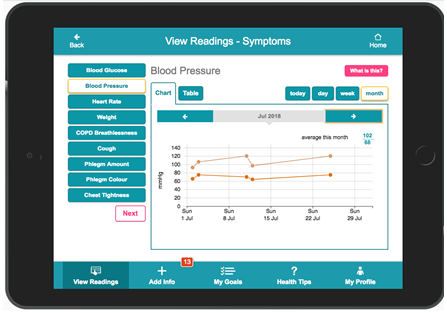
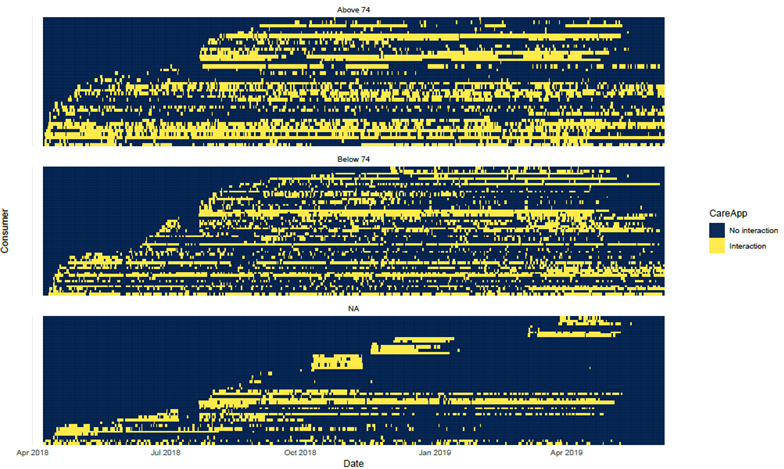
Overview of view readings (Fig. A); Heatmap with sessions for the sample of users by age (Fig. B)
Goal Recommender
A recommender system (RS) is a software tool and technique providing suggestions for items to be of use to a user (Mahmood et al., 2009; Burke, 2007). The suggestions relate to various decision-making processes, such as what items to buy, what music to listen to, what online news to read or in the context of health what educational material may be of benefit to read. “Item” is the general term used to denote what the system recommends to users. Recommender systems have proven to be valuable for online users to cope with information overload and to personalise recommendations to a set of individual and contextual factors, becoming popular in commercial environments (Ricci F. et al, 2011).
Recommendation systems use a number of different technologies, which can be classified into two broad groups:
We have implemented a goal recommender (GR) to assist the PwM using the CareApp to choose a suitable physical activity goal. The objective of the GR is to provide a personalised walking goal. The choice of walking is due to: 1) the activity trackers being used in the trial provide detailed data on walking (steps, distance and minutes), and 2) walking is a type of physical activity that can be performed and is recommended in the guidelines for PwMs. Furthermore, participants demonstrated interest in setting goals based on their physical activity data.
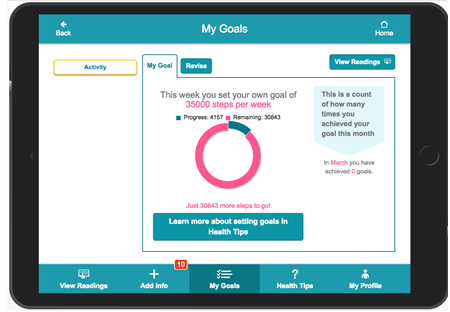
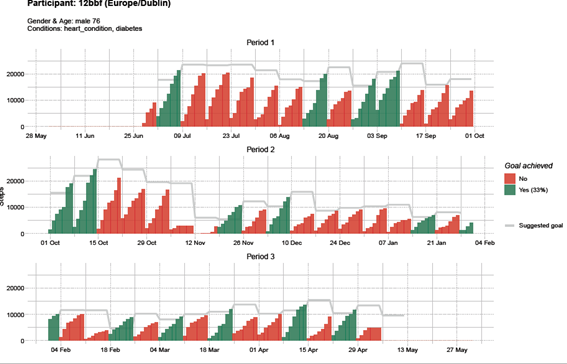
Overview of goals (Fig. A); Example of GR resultse (Fig. B)
Education Recommender
This CareAnalytic recommends tagged educational content (health tips) to improve the engagement of the PwM with the system and therefore, to improve his/her QoL based on increased knowledge acquisition for self-managing. In other words, the ER is a collection of functions that provide added value to the CareApp, allowing a smart personalised selection of training material (tips of the day, videos or other tagged content) based on actions and wellness of each PwM.
Out Education Recommender (ER) has been designed using a three-model approach: in the first model, the ER is focused in giving recommendations on goal setting by looking at two basic engagement metrics: not using goals section, not achieving a goal or a serious decrease in the activity recorded. To that aim, the ER model 1 uses information previously stored and from the results of the UE Analyser.
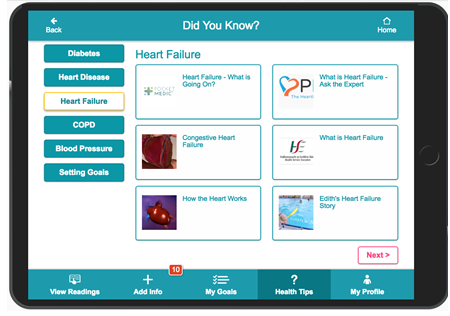
ACKNOWLEDGEMENTS
These developments have been done under ProACT project (CORDIS page). This project has received funding from the European Union’s Horizon 2020 research and innovation programme under grant agreement No 689996.

Made with Mobirise website creator